Landslide Mapping in Calitri (Southern Italy) Using New Multi-Temporal InSAR Algorithms Based on Permanent and Distributed Scatterers
Abstract
:1. Introduction
2. Study Area
3. Materials and Methods
3.1. Enhanced PS (E-PS)
- The identification of pixel examples that are similar from a statistical point of view must be performed. The Kolmogorov–Smirnov (KS) and Anderson–Darling (AD) tests are both based on the amplitude of the co-registered and calibrated stack of SAR data. These tests are specifically designed to detect distributed scatterers (DSs);
- For all of the DSs identified by statistical tests, the covariance matrix that takes advantage of the ensemble of similar pixels is estimated. SLC phases in correspondence with DS are weighted optimally, either by the maximum likelihood estimator (MLE) under the assumption of Gaussianity, or by exploiting the largest principal component of the covariance matrix. The final estimate of the time series of displacement should be made by processing the DS that has a consistency above a certain threshold with the PS.
3.2. Enhanced SBAS (E-SBAS)
- I.
- Estimates the low-pass deformation time series, specifically at the locations of distributed scatterer (DS) points;
- II.
- Estimates the low-pass digital elevation model (DEM)—residual topography.
4. Results
4.1. E-PS Velocity Maps
4.2. E-SBAS Velocity Maps
4.3. IFFI Database Update
5. Discussion
6. Conclusions
Author Contributions
Funding
Data Availability Statement
Acknowledgments
Conflicts of Interest
References
- Donati, L.; Turrini, M.C. An Objective Method to Rank the Importance of the Factors Predisposing to Landslides with the GIS Methodology: Application to an Area of the Apennines (Valnerina; Perugia, Italy). Eng. Geol. 2002, 63, 277–289. [Google Scholar] [CrossRef]
- Wang, L.-J.; Guo, M.; Sawada, K.; Lin, J.; Zhang, J. Landslide Susceptibility Mapping in Mizunami City, Japan: A Comparison between Logistic Regression, Bivariate Statistical Analysis and Multivariate Adaptive Regression Spline Models. CATENA 2015, 135, 271–282. [Google Scholar] [CrossRef]
- Conforti, M.; Ietto, F. Modeling Shallow Landslide Susceptibility and Assessment of the Relative Importance of Predisposing Factors, through a GIS-Based Statistical Analysis. Geosciences 2021, 11, 333. [Google Scholar] [CrossRef]
- Varnes, D. Slope Movement Types and Processes; Transportation Research Board: Washington, DC, USA, 1978. [Google Scholar]
- Cruden, D.; Varnes, D. Landslide Types and Processes; Transportation Research Board: Washington, DC, USA; US National Academy of Sciences: Washington, DC, USA, 1996; pp. 36–57. [Google Scholar]
- Hungr, O.; Leroueil, S.; Picarelli, L. The Varnes Classification of Landslide Types, an Update. Landslides 2014, 11, 167–194. [Google Scholar] [CrossRef]
- Petley, D. Global Patterns of Loss of Life from Landslides. Geology 2012, 40, 927–930. [Google Scholar] [CrossRef]
- Vranken, L.; Van Turnhout, P.; Van Den Eeckhaut, M.; Vandekerckhove, L.; Poesen, J. Economic Valuation of Landslide Damage in Hilly Regions: A Case Study from Flanders, Belgium. Sci. Total Environ. 2013, 447, 323–336. [Google Scholar] [CrossRef] [PubMed]
- Liu, W.; Yan, S.; He, S. Landslide Damage Incurred to Buildings: A Case Study of Shenzhen Landslide. Eng. Geol. 2018, 247, 69–83. [Google Scholar] [CrossRef]
- Guerriero, L.; Confuorto, P.; Calcaterra, D.; Guadagno, F.M.; Revellino, P.; Di Martire, D. PS-Driven Inventory of Town-Damaging Landslides in the Benevento, Avellino and Salerno Provinces, Southern Italy. J. Maps 2019, 15, 619–625. [Google Scholar] [CrossRef]
- Matano, F. Analysis and Classification of Natural and Human-Induced Ground Deformations at Regional Scale (Campania, Italy) Detected by Satellite Synthetic-Aperture Radar Interferometry Archive Datasets. Remote Sens. 2019, 11, 2822. [Google Scholar] [CrossRef]
- Vicari, A.; Famiglietti, N.A.; Colangelo, G.; Cecere, G. A Comparison of Multi Temporal Interferometry Techniques for Landslide Susceptibility Assessment in Urban Area: An Example on Stigliano (MT), a Town of Southern of Italy. Geomat. Nat. Hazards Risk 2019, 10, 836–852. [Google Scholar] [CrossRef]
- Guzzetti, F.; Mondini, A.C.; Cardinali, M.; Fiorucci, F.; Santangelo, M.; Chang, K.-T. Landslide Inventory Maps: New Tools for an Old Problem. Earth-Sci. Rev. 2012, 112, 42–66. [Google Scholar] [CrossRef]
- Calò, F.; Calcaterra, D.; Iodice, A.; Parise, M.; Ramondini, M. Assessing the Activity of a Large Landslide in Southern Italy by Ground-Monitoring and SAR Interferometric Techniques. Int. J. Remote Sens. 2012, 33, 3512–3530. [Google Scholar] [CrossRef]
- Martire, D.D.; De Luca, G.; Ramondini, M.; Calcaterra, D. Landslide-Related PS Data Interpretation by Means of Different Techniques. In Landslide Science and Practice: Volume 2: Early Warning, Instrumentation and Monitoring; Margottini, C., Canuti, P., Sassa, K., Eds.; Springer: Berlin/Heidelberg, Germany, 2013; pp. 347–355. ISBN 978-3-642-31445-2. [Google Scholar]
- Borgia, A.; Tizzani, P.; Solaro, G.; Manzo, M.; Casu, F.; Luongo, G.; Pepe, A.; Berardino, P.; Fornaro, G.; Sansosti, E.; et al. Volcanic Spreading of Vesuvius, a New Paradigm for Interpreting Its Volcanic Activity. Geophys. Res. Lett. 2005, 32, 3. [Google Scholar] [CrossRef]
- Bell, J.W.; Amelung, F.; Henry, C.D. InSAR Analysis of the 2008 Reno-Mogul Earthquake Swarm: Evidence for Westward Migration of Walker Lane Style Dextral Faulting. Geophys. Res. Lett. 2012, 39. [Google Scholar] [CrossRef]
- Cascini, L.; Calvello, M.; Grimaldi, G.M. Groundwater Modeling for the Analysis of Active Slow-Moving Landslides. J. Geotech. Geoenvironmental Eng. 2010, 136, 1220–1230. [Google Scholar] [CrossRef]
- Avallone, A.; Cirella, A.; Cheloni, D.; Tolomei, C.; Theodoulidis, N.; Piatanesi, A.; Briole, P.; Ganas, A. Near-Source High-Rate GPS, Strong Motion and InSAR Observations to Image the 2015 Lefkada (Greece) Earthquake Rupture History. Sci. Rep. 2017, 7, 10358. [Google Scholar] [CrossRef] [PubMed]
- Confuorto, P.; Casagli, N.; Casu, F.; De Luca, C.; Del Soldato, M.; Festa, D.; Lanari, R.; Manzo, M.; Onorato, G.; Raspini, F. Sentinel-1 P-SBAS Data for the Update of the State of Activity of National Landslide Inventory Maps. Landslides 2023, 20, 1083–1097. [Google Scholar] [CrossRef]
- Plank, S.; Twele, A.; Martinis, S. Landslide Mapping in Vegetated Areas Using Change Detection Based on Optical and Polarimetric SAR Data. Remote Sens. 2016, 8, 307. [Google Scholar] [CrossRef]
- Park, S.-E.; Lee, S.-G. On the Use of Single-, Dual-, and Quad-Polarimetric SAR Observation for Landslide Detection. ISPRS Int. J. Geo-Inf. 2019, 8, 384. [Google Scholar] [CrossRef]
- Ge, P.; Gokon, H.; Meguro, K.; Koshimura, S. Study on the Intensity and Coherence Information of High-Resolution ALOS-2 SAR Images for Rapid Massive Landslide Mapping at a Pixel Level. Remote Sens. 2019, 11, 2808. [Google Scholar] [CrossRef]
- Burrows, K.; Walters, R.J.; Milledge, D.; Densmore, A.L. A Systematic Exploration of Satellite Radar Coherence Methods for Rapid Landslide Detection. Nat. Hazards Earth Syst. Sci. 2020, 20, 3197–3214. [Google Scholar] [CrossRef]
- Raspini, F.; Ciampalini, A.; Del Conte, S.; Lombardi, L.; Nocentini, M.; Gigli, G.; Ferretti, A.; Casagli, N. Exploitation of Amplitude and Phase of Satellite SAR Images for Landslide Mapping: The Case of Montescaglioso (South Italy). Remote Sens. 2015, 7, 14576–14596. [Google Scholar] [CrossRef]
- Tessari, G.; Floris, M.; Pasquali, P. Phase and Amplitude Analyses of SAR Data for Landslide Detection and Monitoring in Non-Urban Areas Located in the North-Eastern Italian Pre-Alps. Environ. Earth Sci. 2017, 76, 85. [Google Scholar] [CrossRef]
- Mondini, A.C.; Santangelo, M.; Rocchetti, M.; Rossetto, E.; Manconi, A.; Monserrat, O. Sentinel-1 SAR Amplitude Imagery for Rapid Landslide Detection. Remote Sens. 2019, 11, 760. [Google Scholar] [CrossRef]
- Miele, P.; Di Napoli, M.; Novellino, A.; Calcaterra, D.; Mallorqui, J.J.; Di Martire, D. SAR Data and Field Surveys Combination to Update Rainfall-Induced Shallow Landslide Inventory. Remote Sens. Appl. Soc. Environ. 2022, 26, 100755. [Google Scholar] [CrossRef]
- Perissin, D. Interferometric SAR Multitemporal Processing: Techniques and Applications. In Multitemporal Remote Sensing: Methods and Applications; Ban, Y., Ed.; Springer International Publishing: Cham, Switzerland, 2016; pp. 145–176. ISBN 978-3-319-47037-5. [Google Scholar]
- Devara, M.; Tiwari, A.; Dwivedi, R. Landslide Susceptibility Mapping Using MT-InSAR and AHP Enabled GIS-Based Multi-Criteria Decision Analysis. Geomat. Nat. Hazards Risk 2021, 12, 675–693. [Google Scholar] [CrossRef]
- Casagli, N.; Intrieri, E.; Tofani, V.; Gigli, G.; Raspini, F. Landslide Detection, Monitoring and Prediction with Remote-Sensing Techniques. Nat. Rev. Earth Environ. 2023, 4, 51–64. [Google Scholar] [CrossRef]
- Lu, C.-Y.; Chan, Y.-C.; Hu, J.-C.; Chiu, C.-Y.; Chu, C.-R.; Tseng, C.-H.; Chang, C.-H. Velocity Distribution and Movement of Multiple Slow-Moving Landslides Characterized by an Optimized MTInSAR Workflow. Eng. Geol. 2023, 327, 107339. [Google Scholar] [CrossRef]
- Solari, L.; Del Soldato, M.; Raspini, F.; Barra, A.; Bianchini, S.; Confuorto, P.; Casagli, N.; Crosetto, M. Review of Satellite Interferometry for Landslide Detection in Italy. Remote Sens. 2020, 12, 1351. [Google Scholar] [CrossRef]
- Navarro, J.A.; Tomás, R.; Barra, A.; Pagán, J.I.; Reyes-Carmona, C.; Solari, L.; Vinielles, J.L.; Falco, S.; Crosetto, M. ADAtools: Automatic Detection and Classification of Active Deformation Areas from PSI Displacement Maps. ISPRS Int. J. Geo-Inf. 2020, 9, 584. [Google Scholar] [CrossRef]
- Guzzetti, F.; Ardizzone, F.; Cardinali, M.; Rossi, M.; Valigi, D. Landslide Volumes and Landslide Mobilization Rates in Umbria, Central Italy. Earth Planet. Sci. Lett. 2009, 279, 222–229. [Google Scholar] [CrossRef]
- Bovenga, F.; Wasowski, J.; Nitti, D.O.; Nutricato, R.; Chiaradia, M.T. Using COSMO/SkyMed X-Band and ENVISAT C-Band SAR Interferometry for Landslides Analysis. Remote Sens. Environ. 2012, 119, 272–285. [Google Scholar] [CrossRef]
- Del Soldato, M.; Riquelme, A.; Bianchini, S.; Tomàs, R.; Di Martire, D.; De Vita, P.; Moretti, S.; Calcaterra, D. Multisource Data Integration to Investigate One Century of Evolution for the Agnone Landslide (Molise, Southern Italy). Landslides 2018, 15, 2113–2128. [Google Scholar] [CrossRef]
- Moretto, S.; Bozzano, F.; Mazzanti, P. The Role of Satellite InSAR for Landslide Forecasting: Limitations and Openings. Remote Sens. 2021, 13, 3735. [Google Scholar] [CrossRef]
- Chen, X.; Tessari, G.; Fabris, M.; Achilli, V.; Floris, M. Comparison Between PS and SBAS InSAR Techniques in Monitoring Shallow Landslides. In Understanding and Reducing Landslide Disaster Risk: Volume 3 Monitoring and Early Warning; Casagli, N., Tofani, V., Sassa, K., Bobrowsky, P.T., Takara, K., Eds.; Springer International Publishing: Cham, Switzerland, 2021; pp. 155–161. ISBN 978-3-030-60311-3. [Google Scholar]
- Liu, X.; Zhao, C.; Zhang, Q.; Peng, J.; Zhu, W.; Lu, Z. Multi-Temporal Loess Landslide Inventory Mapping with C-, X- and L-Band SAR Datasets—A Case Study of Heifangtai Loess Landslides, China. Remote Sens. 2018, 10, 1756. [Google Scholar] [CrossRef]
- Zhao, C.; Kang, Y.; Zhang, Q.; Lu, Z.; Li, B. Landslide Identification and Monitoring along the Jinsha River Catchment (Wudongde Reservoir Area), China, Using the InSAR Method. Remote Sens. 2018, 10, 993. [Google Scholar] [CrossRef]
- Wasowski, J.; Bovenga, F. Chapter 11—Remote Sensing of Landslide Motion with Emphasis on Satellite Multi-Temporal Interferometry Applications: An Overview. In Landslide Hazards, Risks, and Disasters, 2nd ed.; Davies, T., Rosser, N., Shroder, J.F., Eds.; Hazards and Disasters Series; Elsevier: Amsterdam, The Netherlands, 2022; pp. 365–438. ISBN 978-0-12-818464-6. [Google Scholar]
- Ferretti, A.; Savio, G.; Barzaghi, R.; Borghi, A.; Musazzi, S.; Novali, F.; Prati, C.; Rocca, F. Submillimeter Accuracy of InSAR Time Series: Experimental Validation. IEEE Trans. Geosci. Remote Sens. 2007, 45, 1142–1153. [Google Scholar] [CrossRef]
- Osmanoğlu, B.; Sunar, F.; Wdowinski, S.; Cabral-Cano, E. Time Series Analysis of InSAR Data: Methods and Trends. ISPRS J. Photogramm. Remote Sens. 2016, 115, 90–102. [Google Scholar] [CrossRef]
- Cigna, F.; Esquivel Ramírez, R.; Tapete, D. Accuracy of Sentinel-1 PSI and SBAS InSAR Displacement Velocities against GNSS and Geodetic Leveling Monitoring Data. Remote Sens. 2021, 13, 4800. [Google Scholar] [CrossRef]
- Monti, L.; D’Elia, G.; Toccaceli, R.M. 20. Analisi del Dissesto da Frana in Campania. Available online: https://www.isprambiente.gov.it/files/pubblicazioni/rapporti/rapporto-frane-2007/Capitolo_20_Campania.pdf (accessed on 10 January 2024).
- D’Argenio, B.; Pescatore, T.; Scandone, P. Schema Geologico Dell’Appennino Meridionale (Campania e Lucania). Atti Convegno Bmoderne Vedute Geol. Dell’appenninoq 1973, 183, 220–248. [Google Scholar]
- Martino, S.; Scarascia Mugnozza, G. The Role of the Seismic Trigger in the Calitri Landslide (Italy): Historical Reconstruction and Dynamic Analysis. Soil Dyn. Earthq. Eng. 2005, 25, 933–950. [Google Scholar] [CrossRef]
- Hutchinson, J.N.; Del Prete, M. Landslides at Calitri, Southern Apennines, Reactivated by the Earthquake of 23rd November 1980. Geol. Appl. Idrogeol. 1985, 20, 9. [Google Scholar]
- Santo, A.; Budetta, P.; Calcaterra, D.; Ducci, D.; Corniello, A.; de Riso, R.; Corniello, A. Appunti Di Geologia Dell’Appennino Meridionale Con Riferimento Ai “Rischi” Ed Alle Risorse Del Territorio. In Memorie e Note Dell’istituto di Geologia Applicata Dell’universita di Napoli; STAMPA: Bregaglia, Switzerland, 1993; pp. 1–63. [Google Scholar]
- Parise, M.; Wasowski, J. Landslide Activity Maps for Landslide Hazard Evaluation: Three Case Studies from Southern Italy. Nat. Hazards 1999, 20, 159–183. [Google Scholar] [CrossRef]
- Crosetto, M.; Monserrat, O.; Cuevas-González, M.; Devanthéry, N.; Crippa, B. Persistent Scatterer Interferometry: A Review. ISPRS J. Photogramm. Remote Sens. 2016, 115, 78–89. [Google Scholar] [CrossRef]
- Li, S.; Xu, W.; Li, Z. Review of the SBAS InSAR Time-Series Algorithms, Applications, and Challenges. Geod. Geodyn. 2022, 13, 114–126. [Google Scholar] [CrossRef]
- Ferretti, A.; Prati, C.; Rocca, F. Permanent Scatterers in SAR Interferometry. IEEE Trans. Geosci. Remote Sens. 2001, 39, 8–20. [Google Scholar] [CrossRef]
- Berardino, P.; Fornaro, G.; Lanari, R.; Sansosti, E. A New Algorithm for Surface Deformation Monitoring Based on Small Baseline Differential SAR Interferograms. IEEE Trans. Geosci. Remote Sens. 2002, 40, 2375–2383. [Google Scholar] [CrossRef]
- Jung, J.; Kim, D.; Park, S.-E. Correction of Atmospheric Phase Screen in Time Series InSAR Using WRF Model for Monitoring Volcanic Activities. IEEE Trans. Geosci. Remote Sens. 2014, 52, 2678–2689. [Google Scholar] [CrossRef]
- Ferretti, A.; Fumagalli, A.; Novali, F.; Prati, C.; Rocca, F.; Rucci, A. A New Algorithm for Processing Interferometric Data-Stacks: SqueeSAR. IEEE Trans. Geosci. Remote Sens. 2011, 49, 3460–3470. [Google Scholar] [CrossRef]
- Fornaro, G.; Verde, S.; Reale, D.; Pauciullo, A. CAESAR: An Approach Based on Covariance Matrix Decomposition to Improve Multibaseline–Multitemporal Interferometric SAR Processing. IEEE Trans. Geosci. Remote Sens. 2015, 53, 2050–2065. [Google Scholar] [CrossRef]
- Ferretti, A.; Prati, C.; Rocca, F. Nonlinear Subsidence Rate Estimation Using Permanent Scatterers in Differential SAR Interferometry. IEEE Trans. Geosci. Remote Sens. 2000, 38, 2202–2212. [Google Scholar] [CrossRef]
- Fialko, Y.; Simons, M.; Agnew, D. The Complete (3-D) Surface Displacement Field in the Epicentral Area of the 1999 MW7.1 Hector Mine Earthquake, California, from Space Geodetic Observations. Geophys. Res. Lett. 2001, 28, 3063–3066. [Google Scholar] [CrossRef]
- Ng, A.H.-M.; Ge, L.; Zhang, K.; Chang, H.-C.; Li, X.; Rizos, C.; Omura, M. Deformation Mapping in Three Dimensions for Underground Mining Using InSAR—Southern Highland Coalfield in New South Wales, Australia. Int. J. Remote Sens. 2011, 32, 7227–7256. [Google Scholar] [CrossRef]
- Hungr, O.; Eberhardt, J.C.E. Estimating Landslide Motion Mechanism, Travel Distance and Velocity. In Landslide Risk Management; CRC Press: Boca Raton, FL, USA, 2005; ISBN 978-0-429-15135-4. [Google Scholar]




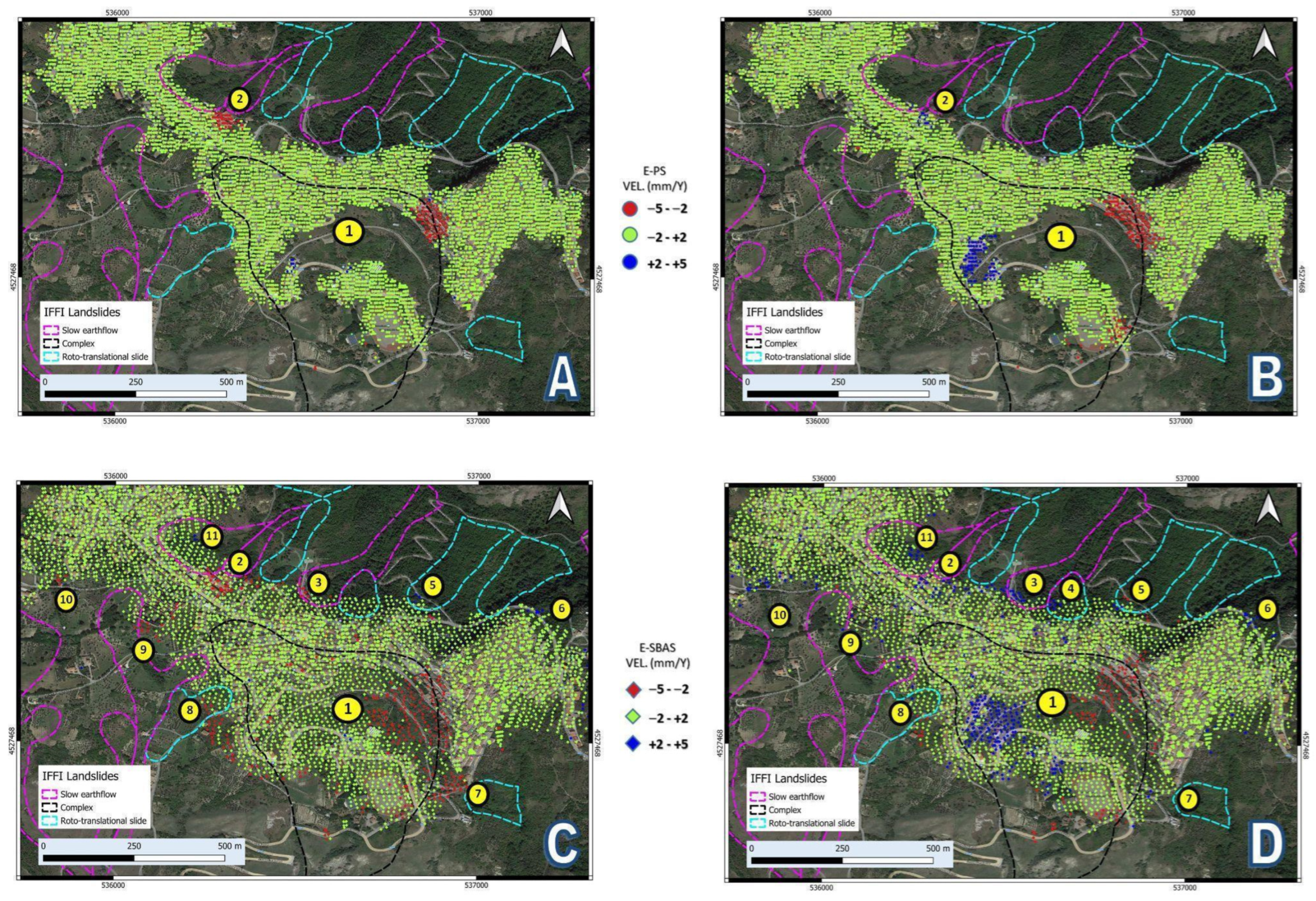
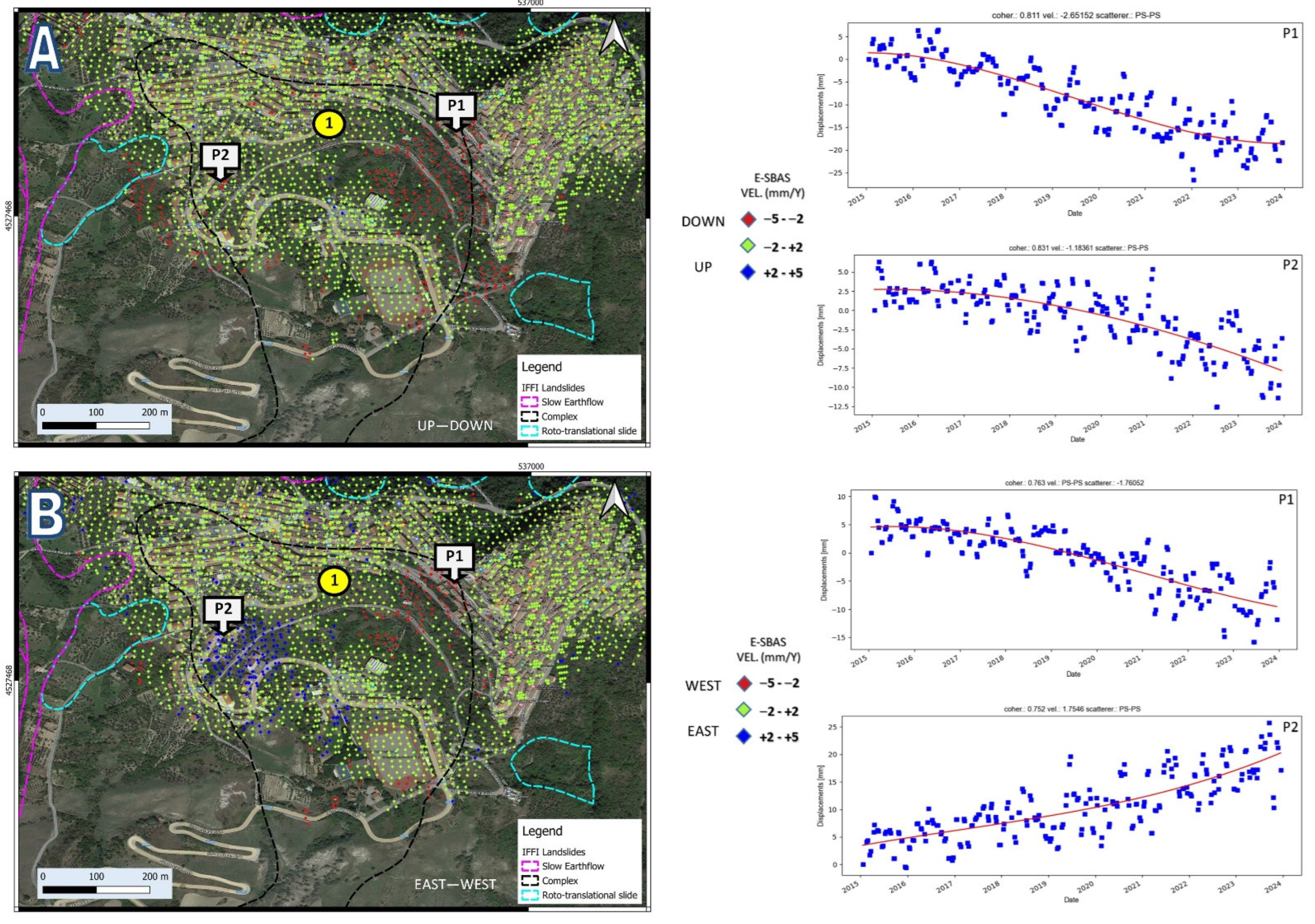
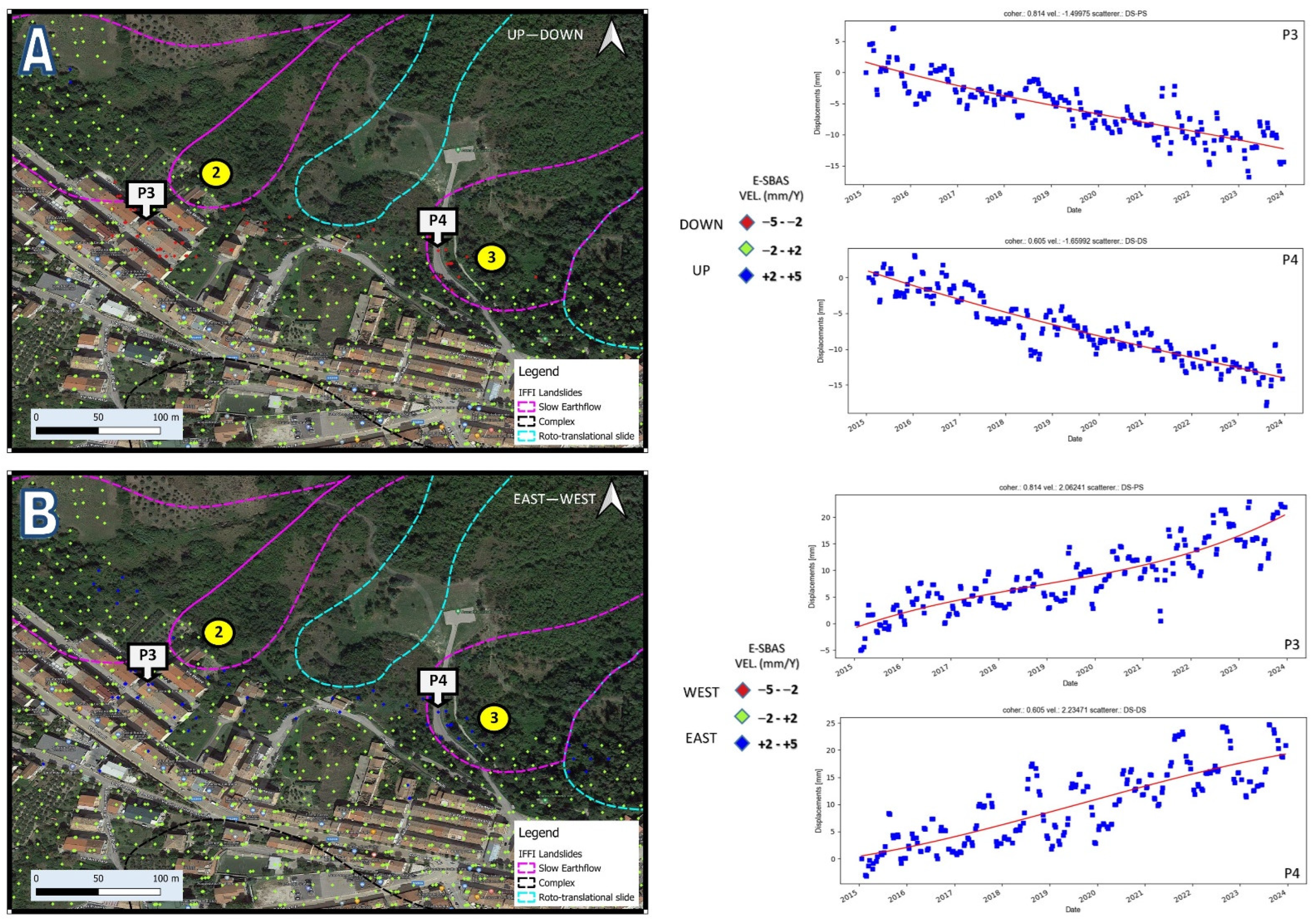
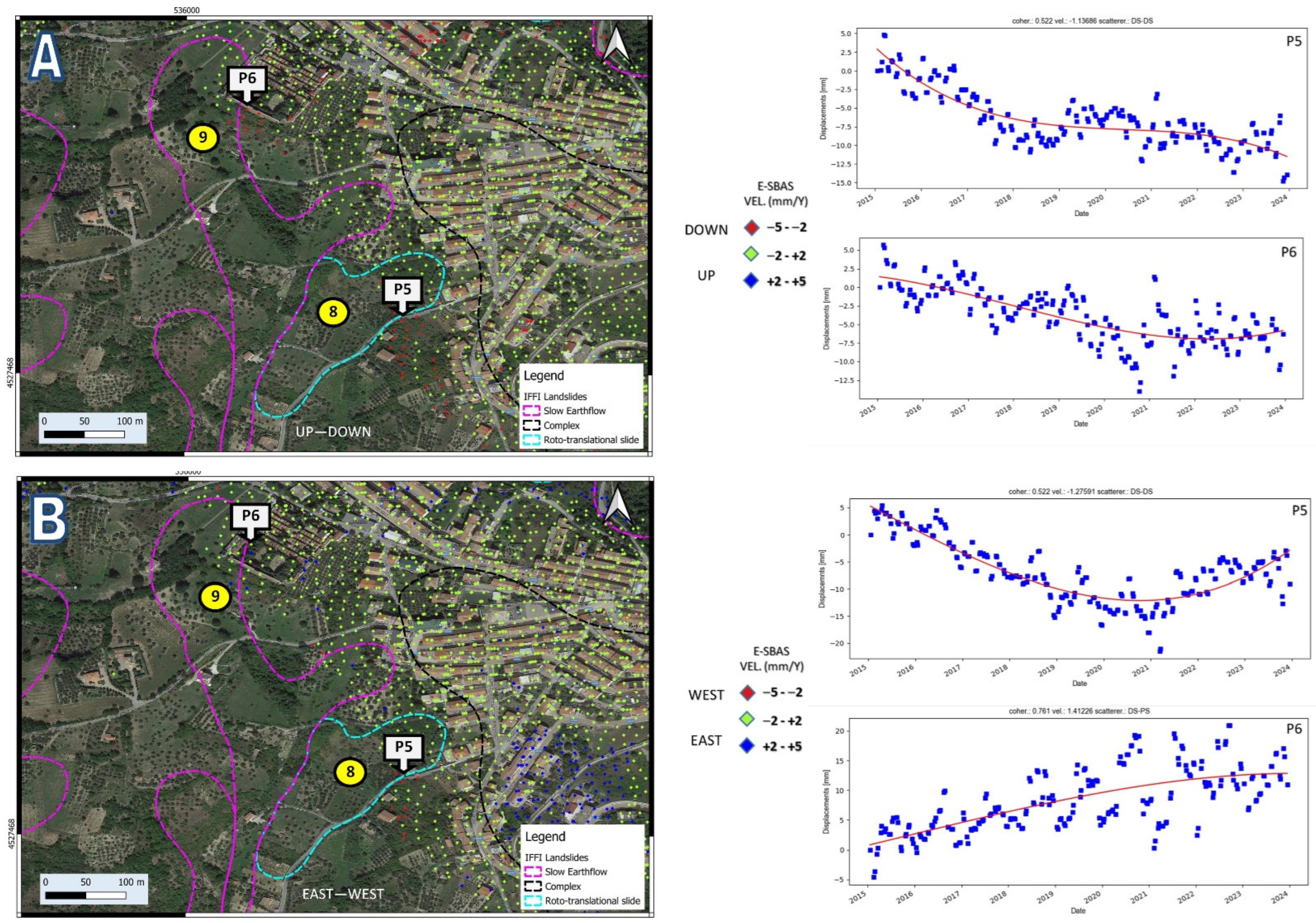
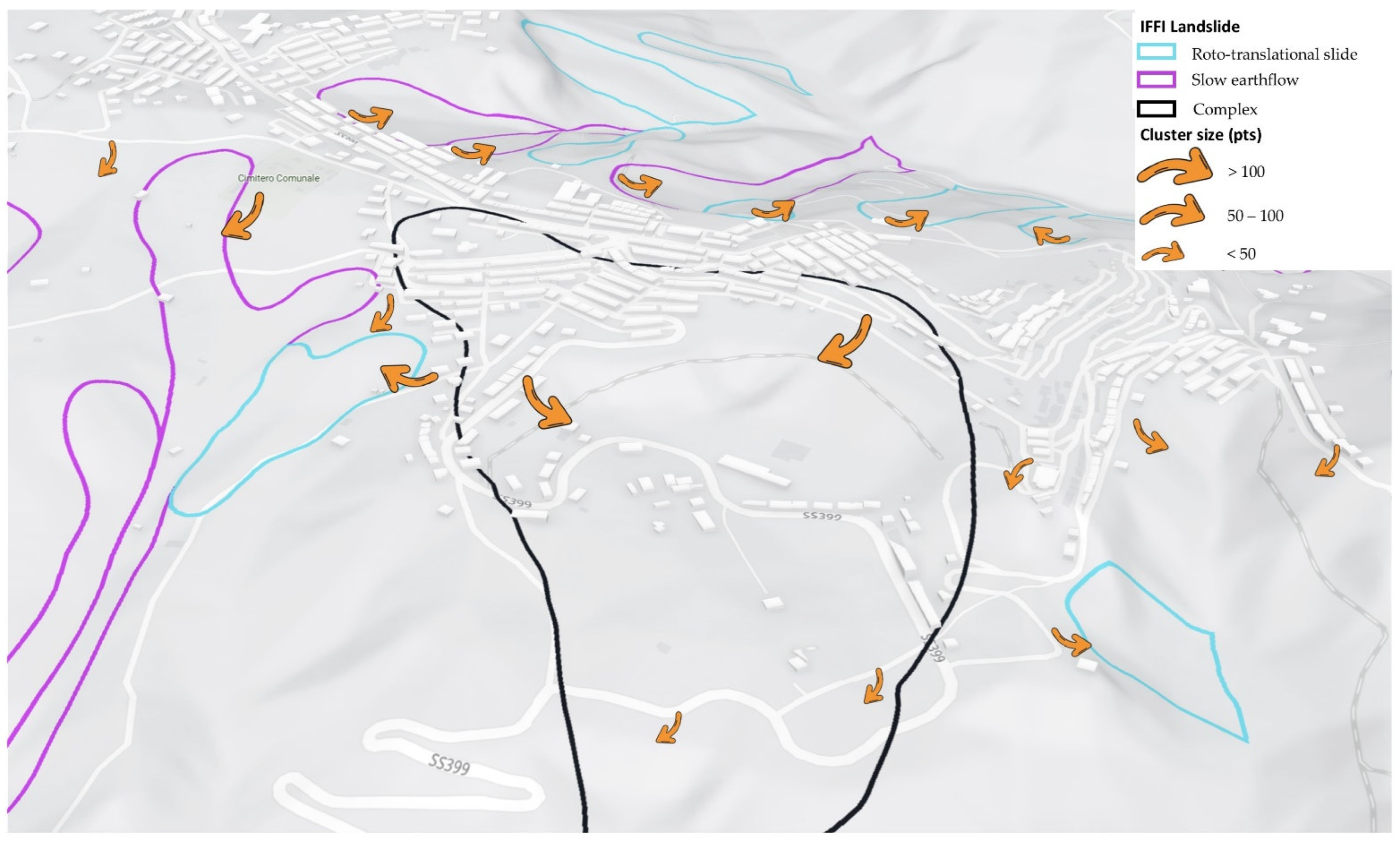
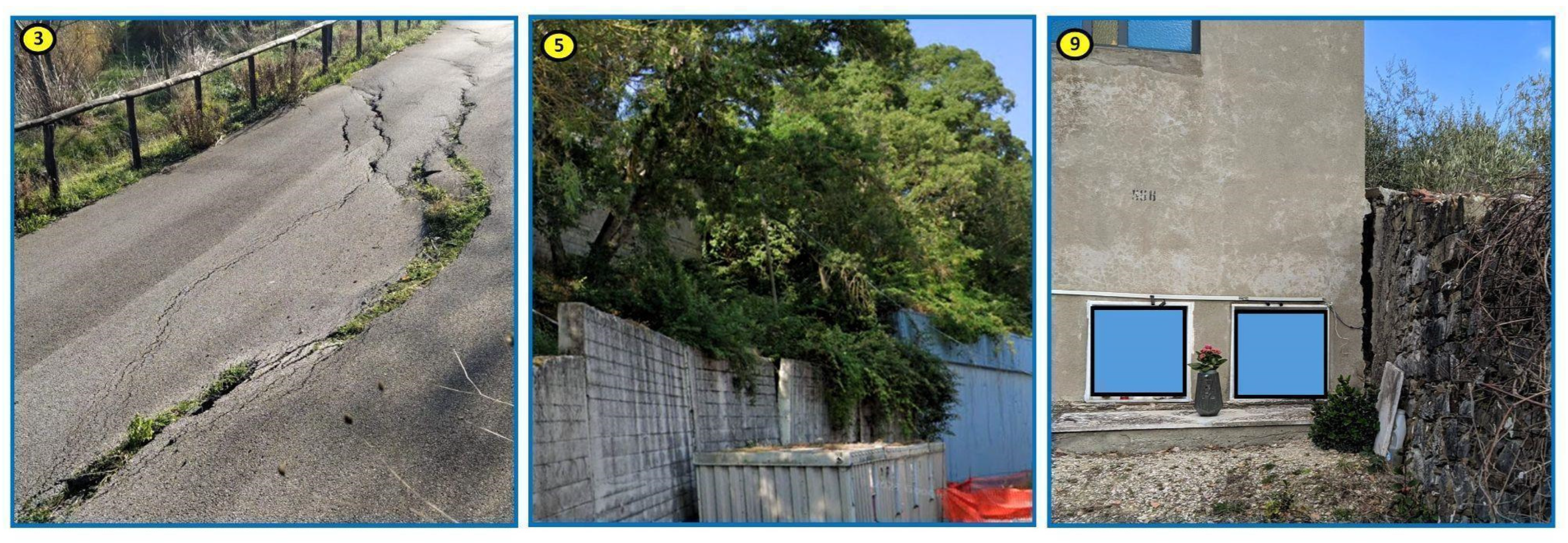
| Satellite | Orbit | Path | Frame | Incidence Angle | Nr. Scenes |
|---|---|---|---|---|---|
| Sentinel-1 | Ascending | 44 | 127 | 42.29 | 108 |
| Descending | 124 | 457 | 38.76 | 108 |
| Algorithms. | Points Number (1.85 km2) | Points Density (km2) | Points Density (ha) |
|---|---|---|---|
| PS | 9795 | 5295 | 53 |
| E-PS | 14,581 | 7881 | 79 |
| SBAS | 7537 | 4074 | 40 |
| E-SBAS | 11,800 | 6378 | 64 |
Disclaimer/Publisher’s Note: The statements, opinions and data contained in all publications are solely those of the individual author(s) and contributor(s) and not of MDPI and/or the editor(s). MDPI and/or the editor(s) disclaim responsibility for any injury to people or property resulting from any ideas, methods, instructions or products referred to in the content. |
© 2024 by the authors. Licensee MDPI, Basel, Switzerland. This article is an open access article distributed under the terms and conditions of the Creative Commons Attribution (CC BY) license (https://creativecommons.org/licenses/by/4.0/).
Share and Cite
Famiglietti, N.A.; Miele, P.; Defilippi, M.; Cantone, A.; Riccardi, P.; Tessari, G.; Vicari, A. Landslide Mapping in Calitri (Southern Italy) Using New Multi-Temporal InSAR Algorithms Based on Permanent and Distributed Scatterers. Remote Sens. 2024, 16, 1610. https://doi.org/10.3390/rs16091610
Famiglietti NA, Miele P, Defilippi M, Cantone A, Riccardi P, Tessari G, Vicari A. Landslide Mapping in Calitri (Southern Italy) Using New Multi-Temporal InSAR Algorithms Based on Permanent and Distributed Scatterers. Remote Sensing. 2024; 16(9):1610. https://doi.org/10.3390/rs16091610
Chicago/Turabian StyleFamiglietti, Nicola Angelo, Pietro Miele, Marco Defilippi, Alessio Cantone, Paolo Riccardi, Giulia Tessari, and Annamaria Vicari. 2024. "Landslide Mapping in Calitri (Southern Italy) Using New Multi-Temporal InSAR Algorithms Based on Permanent and Distributed Scatterers" Remote Sensing 16, no. 9: 1610. https://doi.org/10.3390/rs16091610
APA StyleFamiglietti, N. A., Miele, P., Defilippi, M., Cantone, A., Riccardi, P., Tessari, G., & Vicari, A. (2024). Landslide Mapping in Calitri (Southern Italy) Using New Multi-Temporal InSAR Algorithms Based on Permanent and Distributed Scatterers. Remote Sensing, 16(9), 1610. https://doi.org/10.3390/rs16091610








